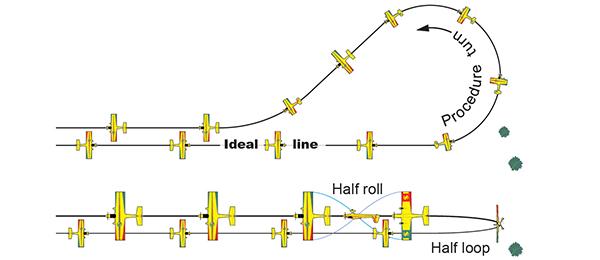by Dave Scott
Lessons in proactive vs. reactive flying
The Immelmann is an aerobatic maneuver that allows you to do a 180° turnaround
Featured in the August 2014 issue of Model Aviation.
The problem with an ordinary turn is that it takes the airplane away from the ideal line that it was on before the turn (figure 1). The pilot is then forced to make several adjustments after the turn to reestablish the preferred line coming back. As a consequence, the pilot has less time to think about what he wants to do next.
The Immelmann is an aerobatic maneuver that allows you to do a 180° turnaround while maintaining the same line of flight coming back, albeit higher, and thereby makes flying easier (figure 2).

Figure 1: Turning around with a normal procedure turn takes the airplane away from the ideal line, and requires more work afterward to return to the ideal line coming back.

Figure 2: Treat the basic Immelmann as two separate parts: a half loop, and then a half roll to upright, with a return to neutral between. They key to performing a good Immelmann is a wings-level entry to ensure that the loop tracks vertically.
Phase I: Sequencing Steps
An Immelmann should be treated as two separate parts: a half loop, and then a half roll to upright, with a return to neutral between them to help ensure that the half roll is axial and not barreled (figure 3). As with any loop, the key to performing a good half loop is a wings level entry to ensure that the loop starts out tracking vertical, rather than veering off to the side with the wings banked. You should target a specific fixed amount of elevator, (e.g., half) in order to establish a consistent initial loop radius. When you execute the half roll at the top, use full aileron in order to complete the half roll quickly before it has a chance to lose undue altitude or wander off heading. Tip: Pro pilots cheat a little and neutralize the elevator and start rolling a few degrees before the airplane reaches the top of the loop to ensure that the roll does not finish sinking or lower than where it started (figure 4).
Figure 3: The result of not returning to neutral between the steps is a barrel roll and loss of heading.

Figure 4: Smoothly pull and hold a fixed amount of elevator (e.g., half) to immediately establish a consistent loop radius. Quickly neutralize the elevator and roll upright a few degrees before the airplane reaches the top of the loop to ensure that the roll does not finish lower than where it started.
Phase II: Floating the Top
The half loop will tend to tighten or “pinch” near the top due to the effects of gravity. The pinch typically starts around 10:00 or 2:00, depending on the direction the maneuver is entered from. These “key points” are where you should reduce your elevator input slightly to “float the top” of the half loop in order to keep it round (figure 5). For the final refinement, input a little forward elevator pressure at the start of the half roll to keep the roll more axial and level at the start (therefore reducing how much you have to cheat). Just remember to remove the elevator push soon after you start the roll to avoid barreling the roll and causing a loss of heading. Altogether, the refined Immelmann is performed by pulling a fixed amount of up elevator to establish a consistent loop radius right away. Between the 10:00 and 2:00 key points, the elevator input is reduced slightly to float the top of the loop. Then a fraction before the airplane reaches the top of the loop, quickly return the elevator past neutral into a slight push while simultaneously rolling upright.










Comments
Immelmann
Often, if your heading changes at the top of the immelmann, it is simply that you have some aileron trim crossed with opposing rudder trim.
This is a good maneuver to find out whether it needs correction.
Dave Scott
Love Dave's articles. Keep them coming please.
video
Great article, would like to see a video too. Maybe you guys can edit a video for us to watch.
Add new comment